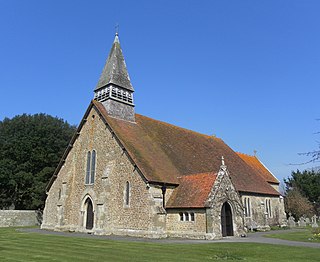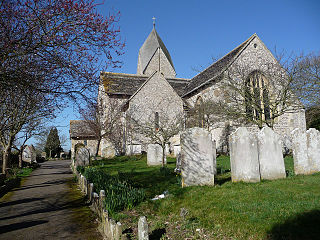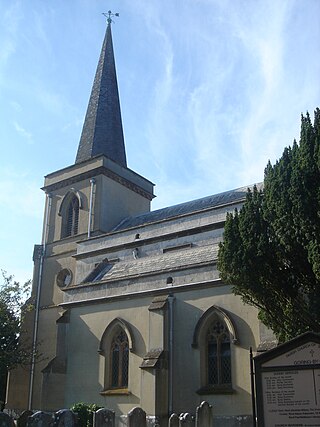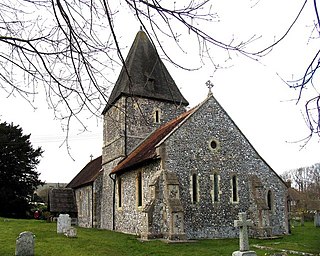
All Saints Church is the Anglican parish church of Patcham, an ancient Sussex village which is now part of the English city of Brighton and Hove. A place of worship has existed on the hilltop site for about 1,000 years, but the present building has Norman internal features and a 13th-century exterior. Several rounds of restoration in the Victorian era included some structural additions. A wide range of monuments and wall paintings survive inside, including one commemorating Richard Shelley—owner of nearby Patcham Place and one of the most important noblemen in the early history of Brighton. The church, which is Grade II* listed, continues to serve as the Anglican place of worship for residents of Patcham, which 20th-century residential development has transformed from a vast rural parish into a large outer suburb of Brighton.

The Church of the Transfiguration is the Church of England parish church of the village of Pyecombe, in the Mid Sussex District of West Sussex, England. The mostly 12th- and 13th-century building, in an isolated setting facing the South Downs, has been designated a Grade I Listed building.

St Peter's Church is the Parish Church of Selsey, West Sussex and dates from the 13th century. The Church building was originally situated at the location of St Wilfrid's first monastery and cathedral at Church Norton some 2 miles north of the present centre of population.

The Church of St Mary the Blessed Virgin, also known as St Mary the Virgin Church and St Mary's Church, is the Church of England parish church of Sompting in the Adur district of West Sussex. It stands on a rural lane north of the urban area that now surrounds the village, and retains much 11th- and 12th-century structure. Its most important architectural feature is the Saxon tower topped by a Rhenish helm, a four-sided pyramid-style gabled cap that is uncommon in England. English Heritage lists the church at Grade I for its architecture and history.

St James the Less Church is the Anglican parish church of Lancing, an ancient village which has been absorbed into the modern town of Lancing in the district of Adur, one of seven local government districts in the English county of West Sussex. It was founded in the 12th century in the most northerly of the three settlements in Lancing parish, which has Saxon origins. The present building is mostly 13th-century in appearance, and structural work has been carried out several times since—particularly in the 18th and 19th centuries, when the church was restored from a ruinous condition. English Heritage has listed the church at Grade I for its architectural and historical importance.

St Andrew's Church is the Church of England parish church of Tarring, West Sussex, England. Founded in the 11th century in a then rural parish which had earlier been granted to the Archbishop of Canterbury, the church remained a peculier of Canterbury for many centuries thereafter. It served nearby parishes when their churches fell into disrepair, John Selden was baptised here, and the church became a base for smuggling. The present building is mostly 13th-century, and its tall spire is a landmark in the area. The church is a Grade II* Listed Building.

St Mary's Church is an Anglican church in the Goring-by-Sea area of the Borough of Worthing, one of seven local government districts in the English county of West Sussex. The late Norman parish church of the ancient village of Goring retains some architectural elements from that period, but Decimus Burton's comprehensive restoration of 1837 has given the church its present Gothic Revival exterior appearance. German artist Hans Feibusch, who worked extensively in the Diocese of Chichester, provided a mural in 1954: it is considered impressive, but caused controversy at the time. English Heritage has listed the church at Grade II* for its architectural and historical importance.

Holy Trinity Church is an Anglican church in the centre of Hastings, a town and borough in the English county of East Sussex. It was built during the 1850s—a period when Hastings was growing rapidly as a seaside resort—by prolific and eccentric architect Samuel Sanders Teulon, who was "chief among the rogue architects of the mid-Victorian Gothic Revival". The Decorated/Early English-style church is distinguished by its opulently decorated interior and its layout on a difficult town-centre site, chosen after another location was found to be unsuitable. The church took eight years to build, and a planned tower was never added. English Heritage has listed the building at Grade II* for its architectural and historical importance.

St Mary Magdalene's Church is a Greek Orthodox place of worship in St Leonards-on-Sea, a town and seaside resort which is part of the Borough of Hastings in East Sussex, England. Dedicated to Mary Magdalene and built in 1852 for Anglican worshippers in the growing new town of St Leonards-on-Sea, a seaside resort which had been laid out from the 1820s, the church's prominent position on the skyline overlooking the town was enhanced in 1872 by the addition of a tower. No longer required by the Anglican community in the 1980s, it was quickly bought by the Greek Orthodox Church and converted into a place of worship in accordance with their requirements. The alterations were minimal, though, and the building retains many of its original fittings and its "archaeologically correct Gothic" exterior which reflected architectural norms of the early Victorian era. English Heritage has listed the church at Grade II for its architectural and historical importance.

St John the Evangelist's Church is the Anglican parish church of the Upper St Leonards area of St Leonards-on-Sea, a town and seaside resort which is part of the Borough of Hastings in East Sussex, England. The present building—a "very impressive and beautifully detailed" church in the Gothic Revival style, with a landmark tower—combines parts of Arthur Blomfield's 1881 church, wrecked during World War II, and Harry Stuart Goodhart-Rendel's 1950s rebuild. Two earlier churches on the site, the second possibly designed by Samuel Sanders Teulon, were themselves destroyed earlier in the 19th century. The rich internal fittings include a complete scheme of stained glass by Goodhart-Rendel's favoured designer Joseph Ledger and a 16th-century painting by Ortolano Ferrarese. English Heritage has listed the church at Grade II* for its architectural and historical importance.

St Peter's Church is a former Anglican church in the Bohemia area of the town and seaside resort of St Leonards-on-Sea, part of the Borough of Hastings in East Sussex, England. Founded in 1883 in response to the rapid residential growth of this part of St Leonards-on-Sea, the "outstanding late Victorian church" was completed and opened in 1885. Architect James Brooks was towards the end of his career but still produced a successful, powerful Gothic Revival design, which was built by prolific local firm John Howell & Son—builders of several other churches in the area.

St Wilfrid's Chapel, also known as St Wilfrid's Church and originally as St Peter's Church, is a former Anglican church at Church Norton, a rural location near the village of Selsey in West Sussex, England. In its original, larger form, the church served as Selsey's parish church from the 13th century until the mid 1860s; when half of it was dismantled, moved to the centre of the village and rebuilt along with modern additions. Only the chancel of the old church survived in its harbourside location of "sequestered leafiness", resembling a cemetery chapel in the middle of its graveyard. It was rededicated to St Wilfrid—7th-century founder of a now vanished cathedral at Selsey—and served as a chapel of ease until the Diocese of Chichester declared it redundant in 1990. Since then it has been in the care of the Churches Conservation Trust charity. The tiny chapel, which may occupy the site of an ancient monastery built by St Wilfrid, is protected as a Grade I Listed building.

The Church of St Mary the Virgin is an Anglican church in Goosnargh, a village north of Preston in Lancashire, England. The church dates from the Middle Ages; it was enlarged in the 16th century and restored twice in the 19th century.

St Michael and All Angels Church is a late nineteenth-century church in the settlement of Partridge Green in the parish of West Grinstead in West Sussex. It was built to cater for the then growing population of the village. Ian Nairn, in the Sussex volume of The Buildings of England, approves of the simplicity of this "flint village church" and comments that most "other counties would have had it much fussier".

St Leonard's Church is an Anglican church in the St Leonards-on-Sea area of Hastings, a town and borough in the English county of East Sussex. The main church serving James Burton high-class mid 19th-century new town of St Leonards-on-Sea was designed by Burton himself just before his death, and it survived for more than a century despite being damaged by the cliff into which it was built; but one night during World War II, the sea-facing building was obliterated by a direct hit from a damaged V-1 "doodlebug" which had crossed the English Channel. The Gilbert Scott brothers' bold replacement church was ready in 1961, and along with a sister church at nearby Bulverhythe served the parish of St Leonards-on-Sea, covered by the Hastings Archdeaconry. Historic England has listed the building at Grade II for its architectural and historical importance.

St Mary Magdalene's Church is an Anglican church in the village of Bolney in Mid Sussex, one of seven local government districts in the English county of West Sussex. The parish church, which is dedicated to Jesus' companion Mary Magdalene, serves a large rural parish centred on a village straddling the ancient London–Brighton road and apparently dates from about 1100, and an older origin has been suggested. Many structural additions have been made over the centuries—including a tower built solely using the labour of villagers—and at the entrance to the churchyard is a "magnificent" 20th-century lychgate made of local materials including Sussex Marble. The church is protected as a Grade I Listed building.

St Margaret's Church is an Anglican church in the village of West Hoathly in Mid Sussex, one of seven local government districts in the English county of West Sussex.

St Leodegar's Church is the Anglican parish church of Hunston, a hamlet in the Chichester district of West Sussex, England. The dedication—rare in England and unique in Sussex—has also been spelt St Ledger historically. A ruinous church dating from the 12th century was dismantled and rebuilt by prolific ecclesiastical architect Arthur Blomfield in 1885, but some old features were retained. The building, an Early English Gothic Revival structure of stone, was criticised by architectural historian Nikolaus Pevsner but was built on a "generous" budget and has some elaborate structural features such as a double belfry.

St Catherine of Siena Church is an Anglican parish church in Cocking, a village in the district of Chichester, one of seven local government districts in the English county of West Sussex.

The Church of St Nicholas is an Anglican church in the village of Iford, East Sussex, England. It is in the Diocese of Chichester, and in the United Benefice of Iford with Kingston, Rodmell and Southease. The building is Grade I listed.



























